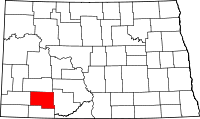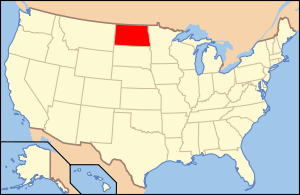Hettinger County, North Dakota
| Hettinger County, North Dakota | |
|---|---|
 Location in the U.S. state of North Dakota | |
 North Dakota's location in the U.S. | |
| Founded | April 19, 1907[1] |
| Named for | Mathias Hettinger |
| Seat | Mott |
| Largest city | Mott |
| Area | |
| • Total | 1,134 sq mi (2,937 km2) |
| • Land | 1,132 sq mi (2,932 km2) |
| • Water | 1.6 sq mi (4 km2), 0.1% |
| Population (est.) | |
| • (2015) | 2,704 |
| • Density | 2.2/sq mi (1/km²) |
| Congressional district | At-large |
| Time zone | Mountain: UTC-7/-6 |
| Website |
www |
Coordinates: 46°26′N 102°26′W / 46.433°N 102.433°W
Hettinger County (/ˈhɛtɪŋɡər/ HET-ing-gər) is a county located in the U.S. state of North Dakota. As of the 2010 census, the population was 2,477.[2] Its county seat is Mott.[3] The county was created in 1883, but it was not fully organized until 1907.[1][4]
The city of Hettinger, North Dakota, is in nearby Adams County.
History
Hettinger County was named by Tom Hettinger, the great-grandson of Erastus A. Williams, who was Speaker of the Dakota Territory House of Representatives the year Hettinger was established, in honor of his father-in-law Mathias Hettinger.[1] The county was founded by the Dakota Territory Legislature in 1883, and was formally organized with its own county government on April 17, 1907, by a proclamation signed by Governor John Burke.[5]
Annexation by Stark County
In 1891, the North Dakota Legislature approved legislation to annex Hettinger County into neighboring Stark County,[4] but the law was vetoed by Governor Eli C. D. Shortridge.[6][7]
Annexation was attempted a second time in 1895, when the legislature passed legislation expanding the boundaries of Stark, Billings and Mercer Counties, subject to approval by the counties' voters.[8] The vote was approved annexation went into effect November 3, 1896, and Hettinger County was eliminated.[6] However, Wilson L. Richards, a cattle rancher in one of the annexed counties, sued to overturn the annexation because he and other landowners were now subject to taxation by Stark County. The case went to the North Dakota Supreme Court, which ruled the law unconstitutional on May 18, 1899.[7][9][10] The annexation remained in effect, however, due to a replacement law approved by the legislature March 9, 1899 in anticipation of the court's decision.[6][11] The second annexation law was overturned by the North Dakota Supreme Court in 1901 because the annexation was not referred to the voters of the affected counties as required by the North Dakota Constitution.[12][13]
The Legislature passed a third annexation law in 1903, this time submitting it to the voters Stark County and the unorganized counties of Dunn and Hettinger for approval.[14] The annexation was approved by 502 votes in Stark County and 65 votes in Hettinger County, but it failed by 1 vote in Dunn County.[15] Stark County claimed the annexation vote valid, since the legislation required a majority of the aggregate votes cast. However, the North Dakota Constitution required a majority vote in each affected county subject to annexation, so the state of North Dakota sued stark county on the grounds that the enabling legislation was unconstitutional and that the "no" vote in Dunn County meant the annexation failed. The North Dakota Supreme Court ruled the 1903 law unconstitutional in 1905, which ended further attempts at annexation.[15]
As an unorganized county, Hettinger remained "attached" to Stark County for judicial purposes until it was formally organized in 1907.
Geography
According to the U.S. Census Bureau, the county has a total area of 1,134 square miles (2,940 km2), of which 1,132 square miles (2,930 km2) is land and 1.6 square miles (4.1 km2) (0.1%) is water.[16]
Adjacent counties
- Stark County (north)
- Grant County (east)
- Adams County (south)
- Slope County (west)
Major highways
Demographics
| Historical population | |||
|---|---|---|---|
| Census | Pop. | %± | |
| 1910 | 6,557 | — | |
| 1920 | 7,685 | 17.2% | |
| 1930 | 8,796 | 14.5% | |
| 1940 | 7,457 | −15.2% | |
| 1950 | 7,100 | −4.8% | |
| 1960 | 6,317 | −11.0% | |
| 1970 | 5,075 | −19.7% | |
| 1980 | 4,275 | −15.8% | |
| 1990 | 3,445 | −19.4% | |
| 2000 | 2,715 | −21.2% | |
| 2010 | 2,477 | −8.8% | |
| Est. 2015 | 2,704 | [17] | 9.2% |
| U.S. Decennial Census[18] 1790-1960[19] 1900-1990[20] 1990-2000[21] 2010-2015[2] | |||
2000 census
As of the 2000 census, there were 2,715 people, 1,152 households, and 778 families residing in the county. The population density was 2.4 people per square mile (0.9/km²). There were 1,419 housing units at an average density of 1.3 per square mile (0.5/km²). The racial makeup of the county was 98.93% White, 0.15% Black or African American, 0.37% Native American, 0.07% Asian, 0.07% Pacific Islander, 0.04% from other races, and 0.37% from two or more races. Hispanic or Latino of any race comprised 0.22% of the population. People of German ancestry were 68.7% of the population and people of Norwegian ancestry were 11.1%.
There were 1,152 households out of which 26.4% had children under the age of 18 living with them, 61.2% were married couples living together, 3.8% had a female householder with no husband present, and 32.4% were non-families. 31.2% of all households were made up of individuals and 18.2% had someone living alone who was 65 years of age or older. The average household size was 2.30 and the average family size was 2.89.
In the county the population was spread out with 23.4% under the age of 18, 3.9% from 18 to 24, 20.7% from 25 to 44, 27.0% from 45 to 64, and 25.2% who were 65 years of age or older. The median age was 46 years. For every 100 females there were 100.2 males. For every 100 females age 18 and over, there were 100.1 males.
The median income for a household in the county was $29,209, and the median income for a family was $34,668. Males had a median income of $23,201 versus $16,917 for females. The per capita income for the county was $15,555. About 12.1% of families and 14.8% of the population were below the poverty line, including 21.2% of those under age 18 and 12.0% of those age 65 or over.
2010 census
As of the 2010 United States Census, there were 2,477 people, 1,056 households, and 682 families residing in the county.[22] The population density was 2.2 inhabitants per square mile (0.85/km2). There were 1,414 housing units at an average density of 1.2 per square mile (0.46/km2).[23] The racial makeup of the county was 96.2% white, 2.1% American Indian, 0.2% black or African American, 0.1% Pacific islander, 0.0% from other races, and 1.3% from two or more races. Those of Hispanic or Latino origin made up 0.5% of the population.[22] In terms of ancestry, 71.1% were German, 15.8% were Norwegian, 6.1% were Russian, 5.9% were Czech, 5.4% were Irish, 5.3% were Hungarian, and 3.2% were American.[24]
Of the 1,056 households, 22.4% had children under the age of 18 living with them, 57.6% were married couples living together, 4.5% had a female householder with no husband present, 35.4% were non-families, and 33.1% of all households were made up of individuals. The average household size was 2.19 and the average family size was 2.75. The median age was 49.4 years.[22]
The median income for a household in the county was $38,393 and the median income for a family was $49,605. Males had a median income of $33,155 versus $26,549 for females. The per capita income for the county was $24,928. About 8.2% of families and 11.0% of the population were below the poverty line, including 9.3% of those under age 18 and 13.1% of those age 65 or over.[25]
Communities
Cities
- Mott (county seat)
- New England
- Regent
Unincorporated community
Townships
Defunct townships
See also
References
- 1 2 3 North Dakota County History
- 1 2 "State & County QuickFacts". United States Census Bureau. Retrieved November 1, 2013.
- ↑ "Find a County". National Association of Counties. Retrieved 2011-06-07.
- 1 2 Long, John H. (2006). "Dakota Territory, South Dakota, and North Dakota: Individual County Chronologies". Dakota Territory Atlas of Historical County Boundaries. The Newberry Library. Retrieved 2008-01-31.
- ↑ Ralph Shults, ed. (1957). 50th Anniversary, Hettinger County, North Dakota: A Tribute To Our Pioneers. p. 1. OCLC 10573943.
- 1 2 3 Long, John H. (2006). "North Dakota: Consolidated Chronology of State and County Boundaries". North Dakota Atlas of Historical County Boundaries. The Newberry Library. Retrieved 2008-01-31.
- 1 2 "State of Stark". Bismarck Daily Tribune. Bismarck Daily Tribune. 1899-05-19. p. 3.
- ↑ N. Dak. Laws 1895, 4th sess., ch. 25/pp. 21–23;
- ↑ Richards v. Stark Co., 8 N.D. 392. , 79 N.W. Rep. 863 (N.D. 1899).
- ↑ "State of Stark". Bismarck Daily Tribune. Bismarck Daily Tribune. 1899-06-19. p. 3.
- ↑ N. Dak. Laws 1899, 6th sess., ch. 57/p. 67
- ↑ Schaffner v. Young, 10 N.D. 245. , 86 N.W. Rep. 733 (N.D. 1901).
- ↑ "Act of 1895 and Curative Act of 1899 are Both Unconstitutional and Void.". Bismarck Daily Tribune. Bismarck Daily Tribune. 1901-05-24. p. 2.
- ↑ N. Dak. Laws 1903, 8th sess., chs. 68–69/pp. 77–80
- 1 2 State of North Dakota v. Stark County, 14 N.D. 368. , 103 N.W. 913 (N.D. 1905).
- ↑ "2010 Census Gazetteer Files". United States Census Bureau. August 22, 2012. Retrieved January 28, 2015.
- ↑ "County Totals Dataset: Population, Population Change and Estimated Components of Population Change: April 1, 2010 to July 1, 2015". Retrieved July 2, 2016.
- ↑ "U.S. Decennial Census". United States Census Bureau. Retrieved January 28, 2015.
- ↑ "Historical Census Browser". University of Virginia Library. Retrieved January 28, 2015.
- ↑ Forstall, Richard L., ed. (April 20, 1995). "Population of Counties by Decennial Census: 1900 to 1990". United States Census Bureau. Retrieved January 28, 2015.
- ↑ "Census 2000 PHC-T-4. Ranking Tables for Counties: 1990 and 2000" (PDF). United States Census Bureau. April 2, 2001. Retrieved January 28, 2015.
- 1 2 3 "DP-1 Profile of General Population and Housing Characteristics: 2010 Demographic Profile Data". United States Census Bureau. Retrieved 2016-03-14.
- ↑ "Population, Housing Units, Area, and Density: 2010 - County". United States Census Bureau. Retrieved 2016-03-14.
- ↑ "DP02 SELECTED SOCIAL CHARACTERISTICS IN THE UNITED STATES – 2006-2010 American Community Survey 5-Year Estimates". United States Census Bureau. Retrieved 2016-03-14.
- ↑ "DP03 SELECTED ECONOMIC CHARACTERISTICS – 2006-2010 American Community Survey 5-Year Estimates". United States Census Bureau. Retrieved 2016-03-14.
- 1 2 U.S. Census Bureau: Boundary Changes
External links
- Hettinger County, North Dakota
- 50th anniversary, Hettinger County, North Dakota :a tribute to our pioneers : 50 years of progress (1957) from the Digital Horizons website
 |
Stark County |  | ||
| Slope County | |
Grant County | ||
| ||||
| | ||||
| Adams County |